This year’s International New York Times Luxury Conference Nov. 13-14 met the volatile social, political and economic climate of today head-on in the European Union’s center of Brussels.
During the 16th edition of the International New York Times’ 2017 Luxury Conference: Luxury in a Turbulent World, Vanessa Friedman, top editors from the news outlet and brand decision-makers discussed matters of politics and economics. Topics during the two-day conference ranged from Europe’s future, the politics of luxury, fake news, populism and pure marketing-based discussions such as communicating to the global consumer and generational behavior.
Sprouted in Brussels
The conference was held Nov. 12-14 in Brussels at the Steigenberger Wiltcher’s Hotel, located on the Belgian capital’s high-street Avenue Louise. Ms. Friedman and her peers led discussions tackling different facets of these tumultuous times, all through a luxury lens.
Brussels was selected as this year’s venue to establish a sense of place for the two-day conference’s topics of discussion, as the city is considered the de facto capital of the European Union.
While luxury often feels as if it exists within a bubble, the political and economic stressors of today will transform how business is conducted regardless of sector and target consumer.
Transformational challenges are not the only factors that need to be considered. The rise of nationalism and the threat of terrorism must also be addressed along with technology’s rapid advancements. Technology is not only altering how consumers communicate, but also their expectations and how purchases are made.
The International New York Times’ Luxury in a Turbulent World brought together thought leaders, influencers, policy makers, entrepreneurs and high-profile brands to explore how luxury can meet these challenges head on “in a world where the only constant is change and the biggest risk is taking no risk at all” (see story).
Here are the five key takeaways from The New York Times’ Luxury in a Turbulent World:
Acting on activism
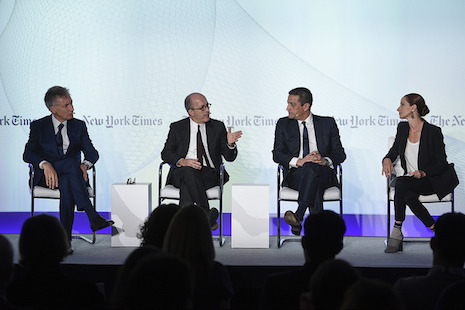
From left to right: Geoffroy de la Bourdonnaye, Jean-Marc Loubier, Jonathan Akeroyd and Vanessa Friedman. Image credit: The New York Times
Luxury brands are in the business of selling dreams and aspirations, but should they also be responsible for standing up for societal issues?
During “The Politics of Luxury” session at The New York Times’ International Luxury Conference Nov. 13, panelists from three luxury houses discussed if it is best for a brand to remain neutral on hot-button issues. While it may be easier to not take a public stance on or against certain issues, millennials’ consciousness is likely to cause brands to make their position known or risk losing a key demographic’s business.
In light of so many issues being on consumers’ minds, Vanessa Friedman, fashion director and chief fashion critic at The New York Times, kicked off the conversation by asking if it is possible for a brand to take a neutral stance.
The panel agreed that, while partially political, sustainability is a much easier position to take as a brand, but the panelists were divided if luxury should be active and vocal in discussions of politics.
At the most basic level, a brand represents a values set, but those sentiments must not jeopardize probability because it is not a brand’s responsibility to make political statements (see story).
All about authenticity
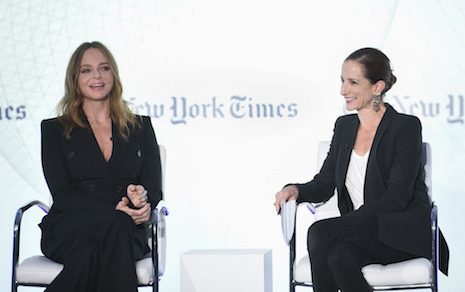
Stella McCartney (left) in conversation with Vanessa Friedman (right). Image credit: The New York Times
While it is easy for brands to get caught up in discussions of targeting demographics and other marketing strategies, they cannot forget about the human element and the importance of being authentic.
For British fashion designer Stella McCartney, this approach has always come naturally as she has guided her eponymous brand into its successes. Speaking at The New York Times’ International Luxury Conference Nov. 13, Ms. McCartney revealed that she and her team spend little time worrying about targeting proper demographics or sweating the details of social media and focus instead on building authentic relationships with consumers organically.
"I’ve always based on everything I do on authenticity," Ms. McCartney said. "That has enabled me to have a voice and conversation with people in a way that has a genuine feeling to it. It makes people feel a little more comfortable."
Marketers and brand executives have become obsessed with the idea of “targeting.” Any discussion of the relationship between brand and consumer ultimately comes back to that word, with questions of how brands can properly “target” certain demographics.
For Ms. McCartney, targeting is a strange and uncomfortable word, conjuring an almost adversarial relationship between brand and consumer.
Instead, she sees her relationship with consumers as something that grows organically from shared connections. The brand does not build campaigns because it thinks they will be interesting to a certain group of consumers (see story).
Diving into diversity
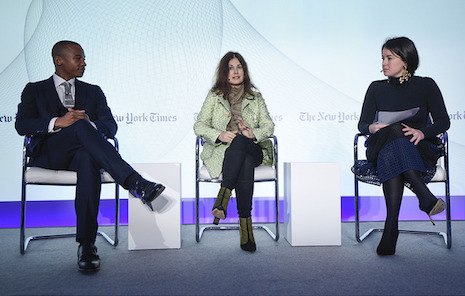
From left to right: Eric Underwood, Rebecca Robins and Elizabeth Paton. Image credit: The New York Times
When discussing diversity in fashion marketing and its importance in the industry, ballet dancer Eric Underwood cited Gucci as a prime example of a brand correctly representing the world of today.
Diversity is vital in all aspects of the fashion world today, but many brands struggle to determine what that means or how to respond. Speaking on a panel at The New York Times’ International Luxury Conference Nov. 14, Mr. Underwood expressed that he feels as though it is a brand’s duty to accurately represent the world we live in and that Gucci has grasped this concept very well.
“I think that the brands have an ethical responsibility to represent the world that we live in,” said Mr. Underwood, ballet dancer, movement director and model. “So if I think of a brand like Gucci, I think of a 12 year-old boy going to school who really wants a new Gucci outfit but I can also think of someone who is going to walk on the red carpet looking to Gucci.
“I feel like they’ve got it right in terms of representing everyone in the world that we live in,” he said.
A major piece of a brand’s part in diversity starts from within, said Rebecca Robins, the global director of Interbrand during the panel. Core values need to start from the heart of the company and extend outward.
When evaluating brands, Interbrand looks at 10 values of a brand. Six of them are outward but four of them occur within the brand. It is vital to elicit change in the world in a visible way, but the real change occurs from within.
To be a strong brand with core values, companies need to be strong inside throughout their entire business (see story).
Populism’s popularity
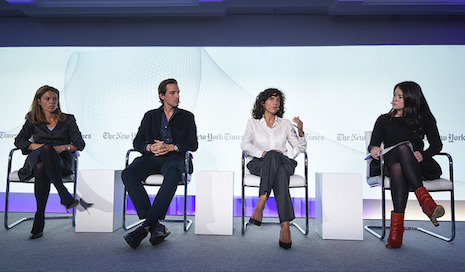
From left to right: Laura Pancera, Alexander Gilkes, Francesca Bellettini and Elizabeth Paton. Image credit: The New York Times
As a result of consumers’ shifting values, luxury has begun breaking down the constraints of intimidation that once stood between it and a client, affluent or otherwise.
With much being discussed about generational differences, cultural shopping behavior and the gap between the haves and have-nots, luxury has had to adapt to the ways in which consumer behavior have evolved. From the use of social media to logos as a status symbol, brands’ values are constantly on display making it all the more important to convey a consistent brand message, rather than focusing on a particular segment of consumers.
During the “Age of Populism: Threats and Theories” session Nov. 13 at The New York Times’ International Luxury Conference, a panel lead by Elizabeth Paton, European styles correspondent, discussed how luxury has responded to the ways consumer behavior and expectation has changed.
This has included Saint Laurent returning to its pret-a-porter beginnings after moving too much toward haute couture, which conflicted with the “dress the streets” ideology established by its namesake founder.
Since 2014, Saint Laurent has returned to its core values of bringing fashion and style to the people. Through its fashions, marketing and state of mind, Saint Laurent’s efforts read as authentic and are consistent with its roots, Francesca Bellettini, the brand’s president and CEO explained.
Also, The art world is also adapting to consumer behavior and the inclusiveness of today’s environment.
Although the art sector has its share of uber buyers, there has been a bevy of new entrants thanks to gallerists and auctioneers’ efforts to encourage novice collectors to buy artwork.
Art collecting, similar to buying high-fashion, can be intimidating, and co-founder Alexander Gilkes explained that Paddle8 wants to help people buy into the dream and aspirations of buying fine art.
“Luxury is very much about dreams, and is antithetical to the rational, but today, the way we sell, experience has to be paramount and key, and the type of experience has also changed,” Mr. Gilkes said (see story).
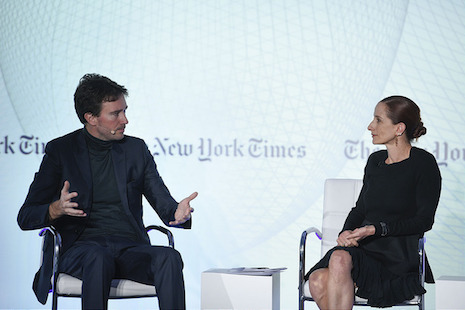
Berluti's Antoine Arnault in discussion with Vanessa Friedman. Image credit: The New York Times
Transparency trending
Consumers today demand more from the brands they engage with, especially when it comes to transparency.
As consumers increasingly desire to engage with brands that align with their personal values and in whom they can place significant trust, transparency is the best way for those consumers to understand exactly what a company is doing. Speaking at The New York Times’ International Luxury Conference Nov. 14, Antoine Arnault, CEO of Berluti, spoke about the specific challenges facing the luxury world in this area.
Consumers are rightfully distrustful of large, powerful corporations. Big companies seem to control every aspect of life today, and whether it is Facebook, Google or Amazon, these corporations do not inspire much trust in today’s customers.
This is especially important to consider now that these consumers are specifically looking for brands that align with their values. For that reason, transparency and honesty are key to developing strong relationships with consumers.
consumers are now empowered to discover their own tastes, opinions and preferences, rather than being hugely impressionable to the powers of everything from well-worded political manifestos to the tantalizing imagery employed by luxury brands.
As a result, this consumer is no longer so easily enticed and seduced. They expect more considered communications from figures of authority, which are sensitive to their more discerning tastes and in line with their elevated expectations (see story).
{"ct":"Dro3V+eySWSOlQcVugC4tjMdqsoj\/up2ci4KN7qVbgfyxlcdaE7e360ONMEPjlSjtTJJ+5jCrhZSBnNQKFuB8mVVUS1Bue7GhhgJz8oo0wtqumuLcB9tNHgS7nriH+P9vG8U20RobtMCAB\/74F\/ZB\/tXIqgEzsx37R2QU5fZtfYaVVeJ65Tm8ViXVuon4dtNoSjlObmLLMqEL4sUzOlQ0DKMgc\/7QmQiSxUMy5dbevqAazCsBjuFhWQ9tQytwQROewPM6EZDBAGTM+uh9rdMNSMZHMlEOP5XqTMAmSkZcUHCUbBO9jnhrzHjQCrl+Wo2PRa9S2Y2OzYtZ2HYfDCBZnO8OSjLyCEJbLKi3qs6shacV\/rE5Ry461oI6icy4ADsKLETa7E\/GwjwZN6dtJ0VOlpJ\/VTXikNjgaeBD77K5gUJUXE9+8GfOpEziZHQkE6m7HIUFidw6+51CYkN5fHzNic87mR7A+eMDlguXdoH23y8wZ+s6nQVkpG0t2\/4QmLBBfaMfRljq1bejz+X4OLh\/6IB+fInC5C9M77+yQMq+v\/wwJLI3bbBAMM3151DfCW6lU3n+sKdL+eNCGqGLUK7eN\/2kB1LzaLIHjxcnmZ\/o0OyEQzcWTuoa1a6Ea3\/YJLDf+0YrdqNRNBoVjaa5y6g7fSAL7Q0UEASykgRXDlDRQEBbsxmTf7LG4Q3Mnh3y7TZkJpDjdf9INS\/AcBR71\/SKA+wxzMRizN21YrIJEPgwAm2FRW5XJ\/1IiHRHGANCeGgBosnV+ecMSYL3147FaYoUbtzELXEfhdt006pff5ckT7N\/c9tzpB+m3HcZHY5seo6lYK8uLwbYsM1Bw0p5YjRVFL8BkfJ8K76TdCjjQvyyMkRI0jkEwm+aPR+uSlmkw3r6pgPchpD6N9pRsRfyJMawRwWK0fu4ImDGKfFHl+EXE6QSIRTN7Zz79YIGlzw4GZpbXidHkDfMukRYp0+pijYP9CwIPcv4xR7SkTEbhncWhCrSwhGZwNvEaxzXjr8Wx4o1F+TNl+ero73aMu0ldlNgWvfzPsbBJmqX2CggdsCmtx0OMunH6zaFlofSAKKB76osYqVCzquFltUKXbovqJQ3Lqx1vRZRMVRbS+50r2vuSEOEa4cn5OOb4BdVnXO4lAvZpqiuHKNx73NERP0RQxHJCyiyzt7Ajh2t1AbHQQpPylEwNzB0H4TacbDByQDsS5BHu+i7IUmTEWGez6ylB2J3WoRpkgpeSgiGmnDqIn0iplbcpahu8fXSWcN3Aa4BEPXuIBMCf5ltNL\/yah30lD\/INnOROWdZXAQxNafr4Y6CbrnL0iJrFQT9MF0YQJ9oQQha1z\/poLX+FA9LYn2n90+qlKnqMUtPwkiLRlN9taBkPFdrGYNjH5vgGO2dssQANhL5LGCEASphmFHASwh6wzjNyfTI0efCJuH3PEp2qz8+BL3AFY\/DieyqFEtd2tWergblPDbKtIs4K0DnQ2hWA7gXua7oHchU20Kot5rU3Wt2WhMoIGPM+xNf8LzIwLgBjSPmijsPugWERXxywrqCnE+rVmhQDdvmbQyznUkeJHkMuz2yL2y0qhK4K6LiTkhamO4wYveQn6nTDDBnETI5J2vhBqVCxqJEHxCaPpgmwkgtyObEicWG4gpcLeA5SbwE2dJTvRemCs6YfhqUKifZxKZJXA9eeciSR3rWJp+UYRsW+PzdLsLAsq0\/DnmEqbtWnn3+hDfcU36bMzD+\/F9e1aWeJbR0eWvw39bu2HZDLYknnqDr3wxUqjSXuZcnIEXlt79YGZnE54fpC\/PllUhDRYVLk6N\/GuYq2fK1RcumKK4KAog5kDT5fB3xjTXcZWCmjd3uZdULFedse1cI4tanSshrIZBmFjJh0r\/OYRTs0WZiF9kdWQl3ZBc1FEovyXjqIzUZzAuOqOumAch\/+U5M2DgR4KlfNYVFNhrS2A87qpjH+LD4WPIvtD4OzrisuNCILdEXVGLdTcl6IlkUgedWMRmc5MCs2hiCWnNdtUotFVF7uTfaRipXWCcx6JF75rDixa9aW0bArNeqxyobq1BYkeFq1oqyNP+g8HKpNlR0mtKznCayem7fUvjSbARVnKCFBsmNW7xfAi87NDZrkBUvBg77zFEptiFH5Jmkg3oCLye+33E9s5LoMYusGL91N9ETp+iv+nVJ0OpRSsbz1OVwU6c5fdwibbl3bZyqIHdp6RjQ39GonH1YtZFahDEB4Nx0taRsgVIm5AC8lSWUFrBQFZALNU7wyswrYaHgQDtIMIQff5NgcUK38WL7ANJZQgR\/q2KKCrwT6XaFFFPRNqIENIsbfvLkjotqNrwQvYv2ENuTT7aLpwobbP7IQgKEFf6t9klZMZ4VmzdErQ2t7eQDxZ\/Mx\/0ubmDqdaUZS5Ez+eSWSugtQqPiriBNZRwqcQto3BxzOW\/5sbf+scjZkTo\/x7PeaY\/AFfWm5CKNFEYVAfvr5z2Zl6eRyxzqUP+WGvqbwX0iWtAqbddgrnMQFBljDNi8Dzlc2BRVSLItADBNOqu0YMAXM7\/ZpxaPSZnINhTRB9NDzgZW0Lri5OFh87OpL9O9oW5YPOGPst9MoYsw3anmWdoDsErB+sDq0bnTMcpeHUNyq72O0xAZXec5PY2BgDpBiqAb7IHG\/5LdlGOZum7RKpssEmqK3Cq2XQC+VwwUzZHcXOjJdKn4QeCwNzxZJyKtizXlVZdcqHzVcBfqaC3oPTuet6TiU4EqjKBh+IhOQXYzlXL7GieFbIfC9xB5zf1n0BG7LASzEbQxxTfldv2EJGo43UewMhiiPBNmxXL6wsODUFqcG\/ULOY64KTtxtt2nKOF\/cDZQZFq8nZn2h1MNsnwc0JumoenuvUOBf5UsUwnJVn2j11lfqz\/TrrnYBM\/5nvIDP22+IsYl+piYgcOA3VFq0HAl4vAXXPjwIOpc\/KGMZXXL5ncoeJs9+2AnJ3rc7LsHJkuI1Vtb3z9rpryu5ZCkUvnk0QxIg953JaSngtjxVhCz3gCxkAU7NgxF8thRBfF6F5vCkgJOcp2w4VjmHZ+1bKdP27ldLW11Kn7syqeTCGeZJA92J8r5WaEzgwUxuf9zRg3whbp\/E7eqRBvl6Z7OwAZ9hi06MDOnFE3GW6KJD7Xr91xEV7cWFuE64yuCeS1N5j8QjgngII2K5jWdZT8L2LNMpi61+jNLjMdgBk3CXg132vOI7u9A+5Mbvg26kcZpUtCC3AAm6V3I0TdFjJelV0QA8cbE8PM3mUSJelgSZtVnHDcNDb\/bB0dSed3xTHo6EA2gDEnmoBmp0\/u5IfY0BJAZvoDZE088qzalTy2R8OdbJ0e2ln+7rkUMHAvUObRA\/7JrWMacdyqoqP7G\/UAmHGkyKo7Yzg0bUHgay\/TodOD7jQcEjw3sUfBVQpGT1AlA\/fs54IITddkmQHfTSN9fAW7VVhRLurIPHZ1kkSWnNYNolTvgRGL9TMdR84\/6GoZISh2gtQgVGbkUhdYG4KkXFH+FqptL+a6Z0aost8kFnhxSUjUZADtgpTjGh8gpZlqsiwJZUMENMgIuIaXYxUir5M1+VIPLxl9UHvGMI5ozNuugvCOHVQiwGgOvJ8L\/KhCfC3ALzmODYH5YQlljajYZmflI6SYv6lJlvwFfsF588DwtnrYZJYHHJx0jWP3G7F97hc1xo1DqUKqdCcm+kyIixeNnDmHiPk7tHSU0hdMwAh84oJIADfxKBmQA4xLgK+K6mSZ+oN2\/qDP+\/ZiPMc8HSSsiZ+JSS5RFCZ2dzs9jJSanovOjCW0J6q3aAlkp16JGR5+F\/nYVK7V6Rm7ka4R\/lSW8dgE+v6xeiZR6xGejIyIWbIrB2jTFjMcsapdv5EfMLFUmgRw5JxOymOHmzSnr2HxopjqzPEdyK1YFogvt2VZ7kC\/ZN55lvDwvTLrcmFVjcvuyU6pnu2Xf3EHLmk43t\/UgxLje5Qsi+OSvNSv87WUETB1lGNm84tY05BTcs\/X+NYwElzy1sHnG7XI5rc7VcBE3V64VM1muPcRBl1C9MndvyTa4Foj0upOUvaWKGMBu6QNpLI2s+lE8iHdGvdr6pwq562WPEHNndKWwRSQ92+4RrjnKMAvpHK1ojH5PJa5BzhaMsYWUA+JC53O9E71X4wtgr1orTkNl1VelEJbKw0B3vz7wYtbGXigtVLHy4zykR1X5RxNxWpW7YxXAKSX3L1xXU7ONK+m5ycKflyO8l5vP6JTzavXnUdUlFeyWGW0ZFmlE1pH0av7E1XDe1J1aPsv5ZbU3fZMAVkAUGPrWNZ3ll5aZUF3z6+1S7o+7kPqI4RnaoSWh5aV\/NWUsKwFXc\/UJpCu18NxynlVQlQyfOIUAYCPc0BZli0l93ymlYZ\/CMJi\/yvzVhqC0jaQ1V6YtSA9EDF2q8OdWh9PccqIWh8YfwEagMOEreib87AXkN0RTgQp2bJ\/u0fhJnkzdTd+gwxTkEhp4ykVB0eHgdUMSWqhBwmmlnp0iJUlLJN3FZiEInP+KmyGX0KRlKSQns3jph2wiWYKq3rUb9Tm1nAPpWGhHZ761BYC1S9IA6ps+T5XjmVPqXPzZ9AJVfQB36YKCeiwynMAbTRQkMX7m95cK4OQVW+CxG8v3Z2xFPyxv9gVWg7rTzX4lW3CZ+Z7P+r7H\/GUcxZnuqm9Dpxilv570kb7BAkP1J7PyJpQrV5ZEnCFL8lZBPjGX8bwW5qX3dEUTHntXkw4x1rubbLGEVS55Z58q++sTgSJ9y5vlSiMI4JiaBPFy3WrYnDRh40cj+Sfk3vesLkL1bQ\/lWUR1m9cGoL1VYEpGN04BGyP7JBoe5ZqfndyoaerHv4t4u4mAlEWL+EYK89lA9WLgxmgAqj7eiICGK5Cs0oE2s4B9aKHj20XBVxBVfSo1xg6Kvw2NJylQD64YFkN9MfprA0JXjHTLY\/zBlVPkvjMLZL0s5ghsYfJEzbwOQmUWDWu\/sNGME7SRk\/YXJdM\/WkwtU7kQkX4MhNv8B2YNpNn9\/GemrdqeOfH17ioDGX+mEqZzpeVA3hPTMGznaDFNs6U34C36TJvPeLwp+wiQagJbxSfxdZc1dww458hQlC72iVpZxcCU4Q2oysCErDNtTVv4ORFMcbYKLJBdhBp+9ZF04Xq0Scn\/76WAuogHzpgawaJsDuwEjDdpSxZg2zQbThrvCN2XjDxCm6OTFQgIny3hIlHaZvMQ5T6lBouVPiQ0ZfC0S6qMaCZZ9cJbZdoaGAzARnSEWIcJYWwLVNQnnI2yKnKcl1n7RdQtW\/R+Mf3pgefUXUDC08K4PYn3ECat9NRGeejAaer9tHey+ciZm7\/AeW2y1FPk27jzbVzi3QWKm2PGCZZxJXA\/XrxyoFt7on3m5CKoRAooBEKTX34P9oaTGKh1Dbm36oROF6PR4eNT350DhKn4iSK1K5MKQGkTQcpabyzgURIrLWk7ekXRts4790CRCnBf\/iZl7OUX2aaj6lABJ7QXEc5PTg0U2PfVR0rkL5OOxEVk1itlZY1hfl6IUQRjlkMDY\/3Ss4ymWmSTx6XOzxloMV\/xUD\/rfW4psR1ZOdDl+JVwPneEGriRqpy2kPpp2OwQVO+ewHRcNpJlzGxqIhfXkxPIJwEeuhMiHQdaJ8iqVWFjvnHmxMuBd0rqpDr1HXzGep32Xd6HkAy7U4UoIoCkEnFZNK2oi4NM0N+2EMxeKc6RlrzdpiW07FdFpdxgkFmzy8xM7BwMcAaSElWPZ5DtS+QMwPmG7Cv63kf0dhqn89HdXbf\/fcy8+IyDb+WQpVAfSinRUTd0h\/tLfOzseZ4lRCAlkUbNyHZc3NmJ3\/w\/0+a172v9gtT0RBtSYOusqAGZ2j9lh+4u6EnprmR8ObA2d1VZ+p5pSNDcAVJAWoncuq2WeQRt0kvbS\/FnFp6a49SilC1PqXGBK6Nr3hA8ABMyRAwcoVQhLsUirPqXBYHz+hU+GzCz6XvsdiujZXwq2cGqPJGHlSZkrqg4lNI0n3CllzsgxD\/HtAWxUc45D0ua\/4O05gbMYgcHw4U9+x16JXHwfw+aqF\/2wc3hpIOuNb5\/n8M5sjJVHRf0ZtLAhmLGdz6a9deAjZihSoN9h7V3GnENBEeANjxTgwqxTmbEc1PC6gRBjK+2rNHKydtQIPupUP1+xb1716zf4Nl6dUxgw7hNmyOAvBBhxAG3e3ft3KfVcRWhfM9C5CYfc29xyxZRSP7t4syHO5CbVv4t7AAsq+WZWDgEUCqnGX+HPf0ldGo32MYZtOEPWg79VmwtGcyRCGWSEsTtHzK9ru\/D3aiIFph7hULvwCmAeg9fogl+\/BQURY1W9bNGiabAZ++y8gaF+r4giLljZ9WPNZYRYypVcvuhPS5ASnDLUqZq4yr51lLalbem5U0wjD1Iw5kBeRgFiTQVvpZaYRES01COO\/sf395T25ABjGyTIIUNPZgxVu1x8HYWgk+yBO5dhYAYoX6NufYsl6Qxgvia4rulajkzQiYFb+eTLHVs\/R+Vj35t2zPvZ8VO5u5\/iy6ZJAn3ItOZb3fpVRBS1Kc+4X0nSlw2t2457yYHF2FRrM7xIGmOi5RaMq6uOSdNI2NwKYWgj72slhAE38iRaZmOZ4uymg9i3qq1csegT+Hd96kf6iO2bbFvcEsvPy4ZL9ZOoVKwPa3V7B+r7GXa1B8GMkhIC13spig7hWPYSLkvdMjI0MKJ2f2gwewFvVfIus1lcvzKnCniK+KmSxEjVE5fQp4HvoSB9jCNDjMKwhZraqS9D0xlPs8wBtnK3xDlaeYQ2sUk12AOSVwEOabpJ0ibXuLblOnt0QSS6iwTNIGT8xg4BQH2MEU5VVexsbRQyi1UMyZryEpeUgQLnqMNc0FN4MsBPT2B\/VAvyqdrzIyRo9EgK3yL8AueRMEtyAsCwsVe52pD0CrRM89cZLGudZ1Y+VZqzTsODuooMsdzvOMIaWgL3Qa\/Q1zdl181hG06LDPjdaMOVe+VLXCXziErnpKYWuVgiuI2HoW3c4bQQvD\/OGFw+Qd+DDfESDArIsZoXamTPfGXac0uqJVRD3\/EGbvfa6f7Wh\/nPNjbtLJ0wimddM2Fh\/rMTmeccaGjkc4uWCYfzjimfC952xYwXpdQvD7lR28b2d4\/S1tcn00CUqFIJ1bjG7+0TcyjylKPZnaHsvLHU9uiKuhK0ps2gmr3y8yoAYQ68RhmlwZonFB3PA7J7G8MP3U6cIY7Jaw92ZXnl3jhgD52eix7MjG5Rx89OeU3K7S8FhMsNCHhH2wI7Ucf4lyta2e6a0HZsgWHyLmiJb9zBF9dum0zX1EfjKhrk\/2PoYqyWUA9OHBrQ\/mf0HvR5PflfqURA6uj0gqnRsJYDafcehdzqJk+yOnu+gsg9DfFCWMHUehwAWUKjWbcU94J+R8slOHzWR5EgiKYTZ5Zkdw7p4FX+WDbPiW46ncS4SUE9pu2Wd4Ktnrpy0K0oNbVDMzSZlg9XrbQ5pA9zqgXvSAmlpl5n\/xPqNMXoyL0fp15VcOrRT5tyLZ8ilSStdhO+E7yq8uC9MvwQg46olzIRifSe5gthKLf1mNLkAR4R5er24jVdZDnJ4gXj4JB62WpvH3A9b7eBObBEIMp\/5EPhzYNu2\/NygA69P9UGi8IX6XVEpZJTQ+IoF6GGSNGFBUObl2C+h0pQl97oK631IoDTP+\/4yOCNMIO1vYm9EzwRGzod24j695ppE4LT4848g60M69uHz3mZz0LP5Qonsar44x3r0x0sq6XfVJ0to1KR+M\/5471KZuXZEyp+SFaUV+\/gIoZF3bSwnJht+20RIH9iSaiqDni73P578jdm8XUVYhLCkoyYxuvXpTmmx7f7BD5czI0wqSTLK60ezmSIspBFJl57RaWRQ5ufWqCOpfcr9Fbf6PXUmNeB2uPJLRXuiz57uXmP782IWHWKajdHawpvolD4mC+7zpGVXQRDtJQlnH1Nags8YBCLFGi+JSurvZ6OPzCEWbSa2kV30KuKxIjIbnsPDyaKhO\/7llifaf0hvV\/SZZf+laMluRf+8j\/EMePJuQWpl\/EwoRygI6B9jnQkoe4B\/BkV5IvOs0YWnO6a5s0YgHM7mBXt8WaGVcYUU+6H7iBo4RETIyDENLquF9muYOc\/xIES7QJchJTw3ZY6YF+P78Lmb8O1K9ra3yZ1KPC9sBo\/1Fo9R0mqhxILGWiGgv\/h3YElfu4234KmsREsUvWPR6Tkg0\/Vo1JAS9xHg9jMcUIeBrOdO368g9k8SyWzQipcw7+H6AeQ8C9\/rRh+J00BLwBM556o+UUbtjkJhMRTyT1Xv3OSM8JMwRFpY2WyLht\/mMZrdkvVY+VoonGIHGI+6ziytPRaC6YO+GmzjOMK\/gX4sPt\/V4fmVur8\/lv9\/SGQihiaDEyS2dsxZYLprQ4XP3wXI\/1GMJinkkntEYNYk6mmWd5e1pWqzy3zm3elCLT+xISoqj2imgTl+WV2VmEWj7mctLXF3suG8fhehP4DRxJBpfA1E0z+33O0JWI2bV+CUjXP5a8sGep6aHheSm46OOlCyMM66lBH921ru6fgamLUHCEW4gpkCsJOpzyVHFQNTz7c49chJuCLHejCWYgRZ7ss8Zv40g0UMpH1QzNxip\/joAab7YGEuyW8zeG2F7omlrI8HgjyDETNHxGk4sjP3IeOiq68d+YnR6Chvmnzxtb8uzUtBLYRzIhqNDpAWxN9xxYkNzQSNVl\/ZlKCCJHj+a9NP34jJ5iFFYYWvJxbHshArfCFOruvW7E9qim3iBQvD4I3BwUiNcJc55sgR8r6CMihUVBatGyQI56pAHWOAwOn\/VKw7dj5ur6FJ7Dxwa+FdV+Q498tF70lmjj5YxrbKYAhdeU34O7ozZGm1Vd3fDuPGUwrRT+Ps2TXTqK8Cd1gueSINu2iYKpu8s1v9HIFSOOTVDhxtVAIfJKqWPhaSkJHX+vf3T6Ib4jp7s68nPPVzqxEoHyC+PmEegU7VvHw5qHPjUnLnCnAJSqfoiuUOjKcjIDUOuYeKLF0Evsd8qpw5u9rFLK3pRvmmaqaKfRiAIeU1EsQxwCCa46Fh9ElMhkOAS9Bg8cLJtXR2xecxtNdON\/FHWJGpPxWiyg+NQx1K25Wl7My0co0iqwDdVHPhTfAQo198gC6ZectGbU+fPdC+KtMqVInZhfp83xyJE\/wVqmBci6SLaXJkVS\/JUiDHDroIVa7bfaoOBphKeYzq4hdgkvo2YZFxfsAq3r44Zzj3BFHg0oZKHjnGrWgoFOI8KTPwN\/Ndntd8wBUIkox91X5IDDwb9yBm2daDttuCHL2300pwX2IcRpX3R5\/h2xd8ell+72\/baFADdJ5tqMUTMcHsqnPMCystD85TbYQZ4nUW8UajtcCA9NElsrErcn8kuwXn7\/5daTHZKoHfmKfsEjuQEAqJUjg1fbG96lEbHBue5jZYkiY70fGH24kQ2ryG8GHMqizsmGpPGETIzcZftHFUIcdiY3lbhOlU8usJE33u3oVVI6RAS7K1\/USdRCu7Fa25FNRBoeSW1pEMqnX2DJT5ClCouLQmj1eFyyOrazdKZhTXfrrFSv6zxqnrWjNpNnnwp66QM2joXSIQBU81Jnywi0dRs3MAi+H2BQqeTEF6veH8H9x2XhwHk1J\/u1TQVPlkaT8bq36lAlNmlBIPe0WWji4yQbkkpYE4bpLnGmY8bddPYxvstByanWEHy\/pw0JDAcczBJKnlXVqEnO5T306Aa3MxmRjtOUVRygQms1XIv+gwrM5sKagzIZo9u7GfMya\/asQNfsY8aOtnMiLh8t4U+zmh9Puw6VM3lyr9B1X0nKaNgAOQcEnsBsZ4cfMQv3z9mRHZTFCnYyGiN6p3jqdH5QGyOR9b3LknQ2gyD3R9b6MOVEYFSpWL17sfw+VXmq1XKDwhAn5QsV76S1i16xPs7ReOYgCn5U1MozCSjjieDgPmqjzIzeXmwc\/4kpcsyVUDHhPcM56ad5EzKk6Z8O\/HCDEwr+pxihTN0GayS\/pLsN\/E0ko98Lf2gipbW9+ndyq1eLQrQb0WgmlBuNLhv17idKz9imexxdfWsKtOR4gAxeEVLIGU2AdemeBn5B91vViXw+bbdMjbr8OQJRjmCXcx\/Ore7ekfQZXWRjQGyR9q0nDkDGLOl8GxjvEBtnzH3ZvFJwdobB5VBTDDLr9NCTaF6WegS3xOm584LlB8l8Ito2Y\/UfgFoq0aHlugxSSJD\/r0HqVZz2GvZWSsva\/NgFLClmtSZHd0TRtwRI+f6HHq510VxFqlbTXTI+fUF3Y+hDmytrTTh1AJS\/YjXaOl1SsNZ2E0TzxSX7Iauj9WwMVTMSdiva1diUzvs0deLbFIDIC2Jz1v8I7\/zJgJSOoUQrxIEUluhtsADqJzVDm2+BA5HuFEQxT+gFX9bOupccXIHJtVljI2U53lBh\/KY6vaWM8CSow6Ap5CnsneO+OICwas74I1MGXHQQIOjkot7CnRM9wzMsavB+qIVYUWBnlbKXvOt203xaZp1new9\/nKoM8vlj5Wam2EheFkpW61mRYG8XZv+kUyEJyxQQK+ufPjgNFj4LYCYdFSqEUu69uERBdjUSEQcZ89ei0iYdVbvwJvUgCiYwe3X0jilw53d7ZbEx5\/5CR55+fS5XA2j1blXwN\/nX5vmDlFKYlrII6DnAQqE1EpTjQTDhJwbZCyKcxQt4wmMyXeysbo0E2HAV\/1kYExrHPMWMVioC2TfRa26qZ5X2sef+NPEzSIEaoGV2QzWkgQFQI6HWvpa4ILMRTIfziFMEqDLYYWXDkfoQjIBD65WcYsU\/Syzso4ytJeWDwaJlWT73f5bDiP9KYMR7pJ7Aqf+da2iwNSXqCg1WUH\/KeyqvDSe1Wwd1KxshuEnF6R6XhDgcQRQOWbWBxG4X7WAIWFL61GSacRE4JC7PZi4H523zcwIP8FhyrN9fGvtB7wIWGEKHehmAjUV8FkbuE4ih+c0ez\/JN\/h48+mhqSdG1QwqKPoXEf5AoH7Pe2GV57aFXeYNLA6tlYxUWaFwTGL2UeithE0ixEPPZc9fF6Kl9mVSbbiSQxKrfF2b07DjpZH6iM6jWIpCNN8Dn62hqGNSevHYSfievnsiFaPMZ10bKVUUEjrhrpsjNdlm1gxiRU8hN0xFMgeVXMOuyVlfqFPiPgA9OFFCZ4fp2CesCBYlEhVxPnmnDnkJGS88wwj5FnHNQ3GDWM9Mmaegr6rw1l+afhg0XVY0PmK4lgip3H\/EBXWSW8uI3xW50zYz+CxbyCBQJNsMxmmsTVxmzy2qtmUChqvBcu2R6TeLSmJcwBmamhy3tplOgDZUOT75WXVbTW65pppvb0IW3FE7KKmQ1s5oh1KfFF64m371KEHhGXESRIcuW6ku+FGX1b9YbJYfOiMKZevTBBq7WjLWChzPqe07dIlRjZ3A5\/gjKIsXPawtu8MvESddq5V12Hyh9d3M6sK9E2LoawTk+DWf\/oH\/Pl1jbohMPi8qTKw2wAFiE1DKIkzLpcoVAQuOlwb46O4UAh9BlQ0sSu9CAsiPSVzXdeMQoZMWzR67p6Pb5x1ImYD2NWA3c7tNVKpWe7KAQf8dtsWtTfNdZTOMeuHVXU2xzAh69g2DWWqXbApjhy4OqNvYNSDox1KJ5qx386kkDeghA6fc2kNpUXLuF\/TjN4lDqT7qjwSrYytrEV02X0ezEyfF7xdmOyBuyZE\/RsafDE2g8+zqvV8cEEP69s\/dMQ563sXWcTJ0pCQMOqZYndxRzHXQrJ35BDt4Ba1IdnSk9SDnNQdYgN6WVl\/TIvfn9m8U2LPurCzDnRbpl3DqmpQJ+st0Tz7oztn0Ril8yodzypXYRwqpTnKw\/D0lpXO6evWHIF1uPiDr3OLMRcnUp1Lood02QXNYbnyt6jMtx9JvCAkjH6ZnqA3hIG49P8bBRGSBNkMR4WfHb8qnu+CtwjMZyGk21sODSQ\/OOSjyvonYtzUrVpFcV3kbpY9CWqb+HhEEp66x7Ji1Y++bqiJp421+zxVkb0VdooepLCGeMeF51LicFGrII3i6P3wD0e9XWtJyLMGrmG4hD9lo9QyBDVHXhK\/\/fK5dG9WGuSzw6BdGFlgHu3b59zhDBcK3NGwzYxWYuIF9jJHZEbOgHo\/O7Vaumtq2veLxIqOVEknm9jXgoBqpng69eERPuo01x3qMepWaBCApb6M9Xiz00CHjQBbPHQZ2A3BmKJM7FuHLJXUcScRKMSqW77SVVZ1BKgcHXHTohblGlKOhJUtDVE2D8P+ouRZK7aJs9adn0kRimc55mXKrVTpqn2QVbLcbjVxLm82fZ4\/BGVGm3GIZXiOgIC0OFj4SgEU4t2etbxROXn9IX2M5jckhz6LVbOE5T1CiI+GU93QGRCDbdK9oDRb8CkfmDpO9JQXf+MdTKoBeBgW5N7aIpgRnx0\/zah9ST6a1ulXYJv9AIqG2F7aLRfwd8nLkoFheJ9WCGf7RswhilRS6Y6VYDkQh9VJt7bPwokYtw\/Rl\/NVZpI032XPb6PJvVPdrLCYwWhhJHupK8\/JdHiSRlxSiHBeB1JNYRzh4sJCwD0tT7F0QH4gz+wISo4m6ggh6V7l3Bq+iLWvAcj6KSSZCtDTnnuIa6G0Kd\/bqvFX\/EhDMX0mqj9M\/hIcu2ixXWL953Dy0YdP8NT1gWd7gJbk6jARO+5xu4WVC10B4Hx52asCrSZ\/\/R6hJ+Uuj34viX2dm0rvTVcji6UbFOB9kN9tN0cMwrtJXgg2nMYGphbQpuWQkU4hOb1XX3ZkrToydBsev+Xu+lEkCazJCwOLflosVQHTXq2Wd1BS1xiBkpV9dz1ANSRq6QL4OLK9d2DvclKoUdLRbBcsPtWpwl5RrGHYgdfz+hUmV+wUyQHW2dzNWQv+0Rfgy41pT8O0tvEjBQ68jzXw0S9pxIOpuo2cMFzOdj305Pp+BsQ3SHstQwR\/ecnbjGWVQ+r7zrxWxJiDpWHDZbLTTLtHYcKMgsDlcm\/qCRYzQ\/8WQyqVJNryV+o+5El8BHNG8KiItnfcpbUJNwkPrqIPHNzeAm1qfKVZF5tfmF\/7NPpc3+TOB8SHaMdJWDSSeGCLBxLMZocqqkz0fHrUWRpNy2s9dppHRFaDFYBKIGatgbmgsyJjorgY7ZorAAjxaqQUK9txqZDPwtH\/bVcedEI3l0sJmzCWRbePuT8+aJGcWW7ltDJgyMsDfH\/es7qNVv\/wEzO\/0Oh6hlxbW3HfxfQcfXBT83B1R43WECI3KzQiGNSalyCGNUVYElyIyvYbO1fa+K\/gH4WlWzcYn0CZ4Xr5DBz7rtBxS+rbAut5R+I7kfzdOlw7wf\/5CZzOnFYXmhv9hsfBxR6BckOmr7cnUVe8SNVylF5tTZ3s4w+G2i+Z\/E\/CaQL9ZUuFn29+ud\/DfciKAOzEqKssuwt9m5+k33lk6\/keqXZLqzI2Utnv9kKcHnitC+qE+dFuG9hPVnyKdY1Zz0RNxD71fEw++YgZNRy4rbIA1uD9c1B9NTHRvMf7GUP6mNxDdjtFQ9aZ433M1pESzoDdmlrZxQ\/Ef4T8Mbm4lf+P2Xjy5NgrTnV7JDzvfWQzt5m+H96MjhE+8NF0WFuldEIrlhv8d5Pk8oHhk2DpmdRLEa3kAnd7o6WrrsmqwjvGyFDZWzynTQ9\/FOjK+\/s1gyy+iXmGs1+f8lQDiw9ctXRzp1Tv96P0vhdsEhmH20jIdlIzd8wiakpNCtbp6KwYT6OVgB5GP0YpGj14gkW8kORNiAIcJfxWjMmDhZjdi7UJnrXiUKUtrnw+eGAcP9LA\/+9m74R5pn9p\/MOZ3zE\/6VlqvR2kHXS5cQN3KZgoCC6e0poacH5YY898LjKb\/933b8ST7iPnE8ZqhZn96\/CLFRqgY7zVD68Y3E\/25wLI2iVCD3BnrLkHTP+DlCQ383DjutiOrWE0M4m7KKo5+kthB1laoSOGP0Sj491lpKiijAckU4vICTXA\/1C30RgLFHiMg8R4mZCLDtKFvp5h7PsT++ITJuXPkCJL4EI7rZHZiIFSCt1GsG9XqAyZ0TP5MCbnrkwShzN3nKEdC\/yZm6hCzNXzGI9MrrkNqnFgn8JDzBSovvuZAjniEp\/TVM9gGJ4UJmcfcsy\/TkdDv1WrFZimk7gd2DnSMwPTr8PvNex8qr1f6EpCGbuV75OAlAGehxc4NabxV5t6nKLc8A0rHJAcKvjfc1sHMw1LcbUkUaBxl\/NfdpcVExH95SGbwoS9yKj6PeiqKAd59mngcUUmC8gvuneEJpm5XdRd+km0SENbDDYNane9YAneA5c1Wrf4gyT6zuzSqg+Jd1UbkL5CRXWsp1dZFZdvqcJz20dEYdR0pHrGZ3ZyDNUNnMMNnMJFrR+0r\/\/wr4\/qXb6r0LF4sAar7O1uO7jjEpY2Y\/6GulBcFBQgPfv9hhr5lSTclzPdhfNochuL5ZFNohYkB6Ak4Mq5kgBtIC62bkHst8I92ijzymK+jREpaw\/ixlE5HOhH97AcrSpEO400dxrqmyCIygerjDJWGRNVKv462NigjkOxRJnCq4gYZc2iLQ+V+0iWLkLCxYRp\/MTGm6ahvO6tPX7JbYrDb9qafZkKGMg9fRQKxHW01kHT5pnmblF4QtruPHD1G7CnoQ+yoFwduibgCQWG7QraI3ufA\/YPwwWcQ3jtwJXYW2bNblDsESIo3HZ0LzfpFLRFOR3UaWPaO4xh9oP5XuO9ERbd\/breaq9EiVW0jy\/jkgjKkcYKRT6aY\/xTzpmlwOyFa8UGnKFSKCJaAt\/LCvD\/o2uY2ls3jDQpB0KALAo3kPC7l8NNiUfV83qzkNHxRe99nAaZM+EauSpyi9PA0LZ9c8vbc+a8+K9eh+6kPc9qJkr3G6EGGlHNg8nblcWz\/W8kpa2AwxIuWH60kP9pHuVn8vMHJysTOhLl6\/pr+WtvLPbZFNQ7gvLbMOyBhUa4XaETDheyi0JxEPCQoTr+KJiRYPHfVZgIfqi4d3l+gbSLY+6QlGjCydjEkOK+b8VYNHILCZybwPXest8\/unVhj78V\/ygiAejswidg+tgd+Tmal1LN8Igtjj3bnNUNBjQs9DWrvaTcEMjMDwZ1wglpnptC9GO\/REPCv6wEYFQSgMuU8CaCrIqZ+HoJj+zgVSVOuKctPXG0+2QWmEIjrPEwjWb2TtaIQCMLrQGeI5mPXl\/9XNhQakOEMmTgtrE\/5OGagLsRUpKVKWNVFswjLNV+G\/5YrEW12ss7\/rCyToxaoZDzqHpzcVNJLXgyrU8wqNyzkcr0uL6+1w+BASchiF5zrE+NEIjHGUO4GY7Qf6jxxQovFRFA\/aNitFyjMBO0oeujvp3C5iGAbeUjA3xxPgHL0VUHdPVk1B1lho6QFs2Qa5HxDSfEIjKQXOOomIwHb5kB+vX+tuT9PtHJUNoeqGXd2Wh8\/9FSqn8xlZ0SIm3KNao2MYD8WEic6gEuQELGsy3tALfmMxqoG0FKBmV81gqEah4uFHc3aO8r1CNN6WI3LegaRSFnVIKL7my2Qg3h3Dhw9AyeQqdqVWnOkYeJV2yOdzubYr5umZ\/QpSm3XgOg2v7JGq2A3U10HACW3a1dREg8ZdWxnstZJB3a6xqV21QbMAkpMB9PsHT0BjtH27MEEZEVjhiVMUjL2lunxUw06byzKbRRS5o0d5Qkg+1mwtd9h0maXOznUtlayXD9OjYKNyzApWVkj7naL2lNGMSeYzJJT4HGqbsZ0PQ7cz+39eJHdLtxFyGLcBA4fkLs6cbdexgdKBK5uGg\/BfyaAvU7OXynVqZXDl847Jgnm1XgfY6qD2FwoYlhsaESk5MdIOb0N21NFTfiObdHokPdHHLI31BBpisf\/9v9Z87FrG6vVGaVigu4ywLBYhey2LldKwTTrZA5DVwpmO480l6McExzyfTKIH4DXg\/KUH7Rkvr6Xlk1yxc21kj9rm1JHN1VGPEOHGM8hWqgw57jp\/b3wcP50veDrqt6xIpn0aQr5Bntrwia71SUUSNlx\/Da9xp4MbfmHJUTQySWOI4kKTVI6s4bB+5Sz6WmxVf5LGVeAXnACijAZ03lEhOqlDLMCzcwE9QV8Yx8TIJimZp66437Ced3aXSUq6XfSGcv8fwnzyQUKuIoMdwFIw0qzspUKUi+1KAD1wE\/NWpemQjQCCvkAuv2J1JR3VjMquRQx5EXhg2IJSl18SbL+GqY+mpDoRLFhNhjKC4Rs1CWsUOyJtdx\/9G7gp+vpi4IboYez\/lphswvtrdrAzpd\/lbi1bhAVjGxIbr17GUcRbjjUp9TrPX1DykwPqclr4v6oBMEOl\/gfLvp5+b+LxjplY3yXgozs3OG0zHVjwN77C+FE5nvMaoqA9n\/sKLKeXD48kzVI1Ij074vQk+R+XL\/0fbVDF8USiOgoLR\/9zxQQXH46+urIEubcvL1KBVBLKx04LNnKmXgi4RlwbVeTfoEUEpEJzCSzT8Covne+\/I3shhGRwNcDPCXm6nrA1TZw5RHpqLrDIDNRyCUGqoQmnVuHz8NvI4ERtvSXyye+ZE4zcH8rnWnNjINsM1cvsHtz0CAm6IIc+8z8rfmwYB9ZFXOae6HO5dpKFmE6jxRUPWGWYQngGAxaTm+wiT6n9SHsGfdwAU9WisTgatW9UQEWdjiV37bKFq33b1kTWj3tuGX0842N2e2zJy4Qm3SM49eOK+V47en7Y+9\/MADX57QWtjlkr8C1Dxm99riudKs33v\/y8TyfgtVzaW5ICFbgIQZdQSbzHb9XftkgNCf0TyP7+TMrGQV3HzpHSUMhYx2WHMQM+NfpyTXsDY4n4AKv9CphHOrMMcSfx8Tth43oBLzlkFulo17ZGhiPIkQYf\/lASwmHK8DSqtIlI4Fcr219Aki0XHPTsAVz5NwzNYG6NfmHV0UH8kkhSlLwcS8IUl6zgL+aaRznYPFKxZg8ckHKbLMx6BcDE5biYjCLkKxbn72pyVWEy1KAzVWN4b7Bj7VhxI39nfkEPqhCFyQSfM3skmcvN6ICMOjGHLx4J2nLfn+SEeYRtRb1L\/d6mEHOacPgECANgJ18wG7AIBKlhko8ixtETNuyL54yvQbEvJerjL\/OXbWPNpW9Ag6YJsN2LzeMBe3qlL0HZ0MB2pkTzOW\/qOkOYa+7SjXTdB+dQM14xWC2N\/DJc5QFIWmrER8XKPlxQk\/nUWPyXg2AIsn1BLbde61XKw8foxGivPNny1OqAEMRfG7wUl1le31vWy4b2k54RJky4pCJaMlAtO4VW4KTLcoHVCn071qU8HP2FK\/SfDKUwY5G\/dVMoCLBdzsXBil9rHwz\/WMlgmkFsXISUsrNlGd4YRnWOaceil7OaS9M3SCQGDWgFrPK8wkXXKDtE9q5ESdiD5XDmHGJ2D3KXOpAOlWYuoiWVZ1CzqWRy+uQZOv1MESPz9Op+9+chz3B3ORLGj68Q4ySI7fUqRCro1W8ebzgjsoMY+wmayTacaE0zt0KjhcwZSPXOcEE5e5oHGNrJhuqScme1JfKpBgOiVljKznZ6jS0jY+bBJJH8pgjJvDBIWhgmEYemQhTVKRJUfGaZj2mnd34BHGqNn7SfiJX0yR0wCTJtqFg6aO\/IOWYxNulnnqjJOkaRYzr5o3CQ1XmzUJRPV3vgw3x0k+5vcMxP4EqaSz7Pf8vQP8tFi\/H6aI8gTDwkfD8abhYcrsxHjMChC7xp8\/XvMvB4X2\/QLe4KpMy9JHNlPMZ9rWZJooAMNwxHmNG9eFYRjLDYnLjMiawC6IVn8vv2RDQlbFu0i\/eTQuF4ZBK\/muVk7MReMcO\/cAIH7W7K8gZ35Xin89L992OFUOeZEH7qp+0LXDc8N740FJzB096L30iLfRWLBDp+yILKf15SpHYD+8BTyPh48WYfLcy0Jpl5EBXvNjzn9Di4cxQ4YaF4lMp2FrpQo2Smb9rWj9YOThU+Sjq5UbHwsKX1kXJ2e6eJyLu+2gzgV2YXf5R4jtP8hBmAZwr36bRLw8t9M0epUeGDoFlFgS8GLjaTEKNdrEAwzsyh7ONYrra19Kkv6GMyHgw8b3xmCCYZ7NzEsCa7DGCSoP9i5RZson4mu7A6MWqs9rLnYL9qtoVLSKV\/I4NOCerqE2in2ytlh6LD4tKsdJLhHIJjmFB0g2n\/qLoK2hTx933dAy5eyplyWQLQpkXkA9LcsWZ1KLhZVmX7U3mv7+vtJAhJ8Yy0B32QC4U0O7NZ4c9kzdcd5laOYdPt9qVEI+QSmpfFRE5mfL8z6GwVrQXY5P+Foesd812VvgOfTMfznsh9tod4ITCfl4wEI2X5v\/VsxyDNhAXCWVrBqVLXbNlnI9ySqTSQT6Z+wO5eWYl\/Ko7SK8f5qAxJPUXnRHIih9oDwUFak2GY1xRs1Bk1wzn8g88JVGYqSBAWn2s8s3PXZTLGrmW+ZUEu3CPW1V83NTV5Hg9DiEQPxTf9SSmGGzD0FJDMCtqyW3zpat9XxqPi34Vm2aqYFPg3rotrCYjj3w\/x08JXwNyeMhbTH\/pEdoRh+ARsV1fKV5UJ5bnnncAstHlddJTApjUKv+UanalLPcHOCNrmegFTVPwMfEfCr80rqbC7bzh\/RD0cfWIMzGwivGvEKEazSFiqcslXx5NGMy5ahMHGZSG+Sc7CMuNQNATXmj6gOYwBTCdvF\/xLYYZ0ErIf3jnzfQ3qNqbfBHSN0H4Uk8LYkp4HGtY10ZmGqMeyEuT6i2c\/0XOHTaLBYOC9o7O+12opaZb4wCF6ZwmlpyPM3fasDk9hSJ3ySNNkL86USQOoAqOdiJluYvCqKp2aMTzBXP\/fDZPs1OxWmTThgtRD7hWxKM5WQvWfvDjWxZGdtaq8HJ1aTneYC3tg6uHN46zBjuY0syYtO+pUSJkbfSoEJPWOyI7XHWldNUgw+Yh8nIHBu+m\/3NrRQ+bSiSyn5BwShtQ+vfuoMBTbpn7JYOLmx5Nsg==","iv":"13ac8fa3902b63aa8706c07f22bd4344","s":"fe3d627427e45cca"}

 Brussels' Arcade du Cinquantenaire. Image credit: Visit Brussels, photo by @lorevinc
Brussels' Arcade du Cinquantenaire. Image credit: Visit Brussels, photo by @lorevinc